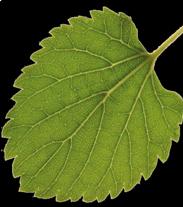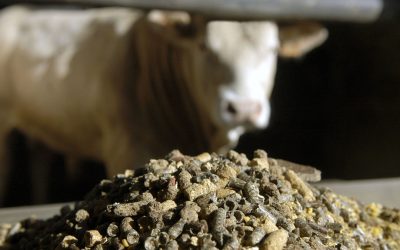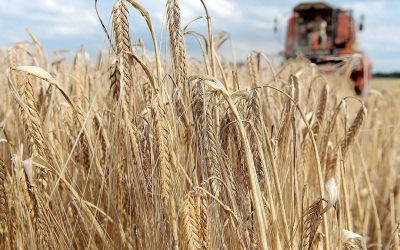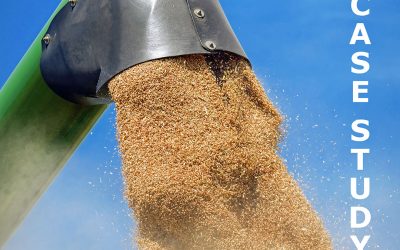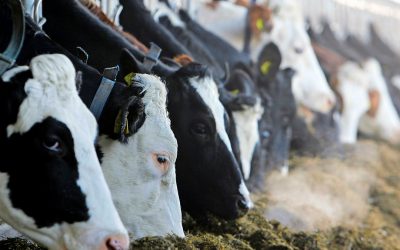Mulberry leaves (Morus alba) are growing under varied climatic conditions, ranging from temperate to tropical, all over the world. The biomass yield of fresh leaves is often in the order of 25-30 tonnes/ha/year with a cutting interval of about 9-10 weeks, while leaves have a high protein content (18 to 25% in DM) and high (75 to 85%) in
vivo DM digestibility (Ba et al. 2005). Therefore mulberry leaves have a high potential as a protein-rich forage supplement to be used in feed for monogastrics, ruminants and rabbits (Benavides 2000). Since mulberry leaves are rich in nitrogen, sulphur and minerals (Singh and Makkar 2002) they have the potential to be used as a supplementary feed for improving livestock productivity.
However, little information is available on their nutritive value and benefits, as a high-quality supplement to low-quality roughages or replacing grain-based concentrates in ruminant feeding. The objective of the present study was to evaluate the nutritional value of mulberry leaves in terms of chemical composition, nitrogen solubility, non-protein nitrogen, protein fractionation and in vitro true digestibility of DM and to determine the effects of mulberry leaves, partially substituting lucerne hay and concentrates, to the digestibility of sheep diets.
Laboratory analyses
Mulberry leaves (the white mulberry variety Local 1) were obtained from a plantation kept by the Department of Sericulture at the Agricultural University of Athens that was periodically harvested. The mulberry leaves were
shadow dried for 12 days before their nutritional value was determined in vitro and used in a digestibility trial with sheep at the Department of Nutrition Physiology from the same University. All samples were ground in a Wiley mill (1-mm screen) and stored in airtight jars before further nutritional evaluation. Nitrogen (N) solubility was determined using the solvents: a) McDougall’s buffer, b) 0.02 N NaOH and c) 0.15 N NaCl, as described by Crooker et al. (1978). Solubility was determined using a concentration of 25 mg feed N/100 ml of solvent (Wohlt et al. 1973; Crooker et al. 1978).
The amount of extracted N was determined in a 50-ml aliquot of supernatant liquid and the soluble N reported as a percentage of the total N in the feed. The soluble non-protein nitrogen (NPN) was determined in the 50 ml solution containing the soluble N fraction by precipitating the protein with trichloro-acetic acid (TCA) using the procedure described by Ganesh and Grieve (1990). Total true protein content represented the difference between the crude protein and the soluble NPN fraction. Soluble protein fractions were obtained via consecutive
extraction procedures (Gavrilyuk et al. 1973) that used 1 N NaCl in phosphate buffer (pH 7.0), 70% ethanol and 0.05 N NaOH. By classic definition (Osborne 1924), these solutions extracted albumins, globulins, prolamins and glutelins, respectively. The remainder was calculated by difference and characterised as insoluble (or structural) proteins.
All chemical analyses were done in triplicate. Samples were ground through a 1-mm screen and analysed for contents of dry matter, organic matter (OM), ether extracts (EE), crude fibre (CF) and crude protein (CP) by standard methods of the Association of Official Analytical Chemists (1990). The N was determined on a Kjeltec Auto 1030 Analyzer (Tecator) using selenium catalyst and 1% boric acid with bromocresol green/ methyl red indicator solution. The filtrate (50 ml) was analysed by the macro-Kjeldhal procedure (AOAC 1990) for soluble N determination. Neutral detergent fibre (NDF), acid detergent fibre (ADF), acid detergent lignin (ADL), cellusose and hemicellulose contents were analysed as outlined by Van Soest et al. (1992). Chromic oxide (Cr2O3) was determined in samples of feed and faeces by acid digestion and spectrophotometry at 440 nm following the procedure described by Fenton and Fenton (1979). The in vitro true digestibility of DM (IVTD) was estimated using sheep rumen liquor as the source of microbial enzymes for the ruminal phase of digestion according to Goering and Van Soest (1970) using a neutral detergent solution and a DAISYII Rumen Fermenter.
Experimental set up (in-vivo trial)
For the determination of apparent digestibility of experimental diets five wethers of the Karagouniko sheep breed, averaging 50.2 kg (SD=1.6) body weight, were used in two feeding periods (treatments). Sheep were individually housed in metabolism crates and fed the prescribed ration each morning for 19 days with tap drinking water always available to them. The first 11 days were used as an adaptation period for the sheep and the last 8 days as the main feeding period where feed consumption and faecal excretion were recorded on a daily basis.
Faeces were collected daily, weighed to the nearest 1 g, put in plastic bags and frozen at −18°C until further analyses. A 40 g sample of all feeds offered and of residues (if any) was retained daily and bulked on a period basis. A gelatin capsule containing 0.5 g Cr2O3 was daily administered orally to each sheep for the parallel determination of apparent digestibility during the main feeding period. Calculation of the apparent digestibility coefficients was performed as described by Owens and Goetch (1988). In the first period of the experiment, a control diet consisting of lucerne hay (590 g) and a concentrates mixture (400 g) was offered
to the animals. The composition of the concentrates mixture was: 50% barley, 49.5% wheat bran and 0.5% vitamins and minerals premix, all ground through a 3-mm screen mill. At the second experimental period the diet consisted of lucerne hay (440 g), dried mulberry leaves (300 g) and a concentrates mixture (260 g). The composition of this mixture was: barley 77.5%, wheat bran 19.3%, bicalcium phosphate 2.7% and vitamins and minerals premix 0.5%, all ground through a 3-mm screen mill. The two rations were designed to be similar in energy, protein and mineral contents.
Composition of feed
The chemical composition of the shadow dried mulberry leaves used in the present study was (g kg−1 on dry matter basis): 163 ash, 201 crude protein, 120 crude fibre, 37 ether extracts, 479 nitrogen-free extracts, 268 neutral detergent fibre, 148 acid detergent fibre, 41 acid detergent lignin, 121 cellulose and 107 hemicellulose. These figures show comparatively high levels of ash, CP and NFE in mulberry leaves, while CF and the fibre fractions are low. Thus, Sanchez (2000) noted that the fibre fractions in mulberry leaves, harvested from a range of varieties, were: NDF=24.6% and ADF=20.8–23.1% of DM and concluded that fibre fractions in mulberry leaves are low compared to other foliages. Shayo (1997) reported lignin (acid detergent lignin) contents of 8.1% and 7.1% of DM for leaves and bark, respectively, while Schmidek et al. (2000) found that the cell wall constituents were: NDF=30.2–39.3%, ADF=17.2–21.7% and hemicelluloses =11.0–22.0% of DM in three clones of mulberry leaves.
Recently, Yao et al. (2000) reported that the NDF content of mulberry leaves increased with stage of maturity regardless of season. In the present study the solubility of total nitrogen in mulberry leaves, in the three solvents used, was 11.6% (in 0.15 N NaCl), 12.4% (in 0.02 N NaOH) and 14.9% (in McDougall’s buffer), while the in vitro true digestibility of dry matter of mulberry leaves was determined at 89.9%. The in vitro true digestibility of dry matter of mulberry leaves found in this study is in agreement with the data reported by Sanchez (2000)
who found very high digestibilities of mulberry leaves in vivo (78.4–80.8%) and in vitro (80.2–95.0%). In addition, Shayo (1997) reported that the in vitro dry matter digestibility of mulberry leaves was 82.1% and the rate of in sacco dry matter degradation was very high (80% of the DM disappeared after 24 h of incubation). Soluble non-protein nitrogen, total true protein and the protein fractions of albumins, globulins, prolamins, glutelins and insoluble proteins in mulberry leaves are presented in Table 1. The soluble NPN was 26.1% of total N, while the total true protein was 14.4% of DM. The major protein fractions were prolamins and albumins accounting for 44.1 and 11.1% of total true protein, respectively. Phiny et al. (2003) found that the DM solubility of fresh and sun dried mulberry leaves, in water, was 40.4 and 30.3%, respectively. Nitrogen solubility values in this study were similar to those reported by other workers using various solvents. Recently, Singh and Makkar (2002) reported that the solubility of nitrogen of mulberry leaves in borate phosphate buffer and phosphate buffer was 17.3 and 15.7% of total N respectively and suggested that all soluble N was in the NPN form.
Singh and Makkar (2002) found that the non-protein nitrogen content of mulberry leaves accounted for approximately 22% of total N in young leaves and approximately 14% in mature leaves. The soluble NPN content of various feedstuffs (e.g. cereals and plant protein sources) has been reported to range from 4.4-24.8% of CP and forages to contain a large amount of soluble NPN (Nikokyris and Kandylis 1997). Similar values have been reported by Krishnamoorthy et al. (1982) for cereal grains, but they found soluble NPN to represent a substantial fraction of total N in forages. Furthermore, Prigge and Apgar (1972) found that the soluble NPN in forages ranged between 20 and 30% of total N, whereas Burghardi et al. (1980) reported that NPN content of corn silage was 36.5% of total N and this level tended to increase with higher levels of microbial additives.
Protein contents
Nikokyris and Kandylis (1997) reported that total true protein values of various feedstuffs ranged from 7.1- 37.7% of DM, while for energy feeds (cereals) composed primarily of prolamins and glutelins, the mean total true protein was 10.2%. The main protein fractions for energy feeds, such as cereal grains, are prolamins and glutelins, whereas, for plant protein sources, the major protein fractions were albumins and globulins (Nikokyris and Kandylis 1997). This is in agreement to the results of Wohlt et al. (1973) and Kretovich (1986) who showed that feedstuffs composed primarily of albumins and globulins had a higher solubility in water and salt solutions than those with protein composed primarily of prolamins and glutelins, which are soluble in alcohol and dilute in alkali. It is generally accepted that nonprotein N and the soluble protein fractions of feedstuffs are usually those degraded within the rumen. The important attribute of the soluble NPN content of mulberry leaves is that this fraction is rapidly degraded in the rumen and, if is too high, the resulting high concentrations of ruminal NH3 will not be utilised by rumen bacteria. Instead it will be absorbed through the rumen wall into the blood and excreted as urea thus leading to a reduced efficiency of N utilisation. However, considering the moderate value of the soluble NPN fraction of mulberry leaves found in this work, as well as the fact that the effective CP degradability of mulberry leaves in the rumen, has been reported to be 54.9% (Liu et al. 2001), 57% (Singh and Makkar 2002) and 63–70% (Schmidek et al. 2000), it is confirmed that this feed would result in satisfactory efficiency of microbial protein synthesis in the rumen, leading to higher microbial protein supply to the intestine.
Digestibility parameters
Table 2 presents the calculated chemical composition of the experimental diets offered in the digestibility trial after considering all components. These diets had an appreciably similar chemical composition, which allowed for digestibility comparisons. The apparent digestibility coefficients of dietary nutrients of the two sheep diets, as determined by the classical method and by using the Cr2O3 method are shown in Table 3. There were no significant differences in DM, CP or CF digestibility for the control and the diet where mulberry leaves replaced
lucerne hay and concentrates, but there were significant differences in ash and ether extract digestibility coefficients for the two diets, as determined by both methods. However, the reason for the different results of the dietary nutrient apparent digestibility coefficients obtained by the classical method of total faecal collection and the use of Cr2O3 as marker is not clear. Jayal and Kehar (1962) found that the digestibility coefficients for CP, EE, CF, NFE and total carbohydrates in sheep fed mulberry leaves were 71, 4, 54, 84 and 76% respectively, whereas Subba Rao et al. (1971) reported that the digestibility coefficients of organic matter, CP, EE, CF, NFE and total carbohydrates in cattle were 58, 69, 73, 49, 60 and 56% respectively. Other workers have also reported similar values for the digestibility of the cell wall constituents.
Mulberry leaves in animal feeding
The potential of mulberry leaves as a fodder crop has been investigated through in vitro studies in other parts of the world (Saddul et al. 2004). Recently, Liu et al. (2001) and Yao et al. (2000) reported that mulberry leaves may be used as supplementary protein source for ruminants, while Shayo (1997) reported that mulberry leaves were a good source of energy and protein for ruminant animals. Feeding experiments with ruminants have showed that the nutritive value of mulberry leaves is as high as some well-known good quality fodders.
Diet supplementation with mulberry leaves has been reported to lead in increased body weight gains in growing lambs (Benavides 2000), growing goats (Gonzalez and Milera 2000), whereas Ba et al. (2005) found that milk production increased with the levels of mulberry offered to goats. Jayal and Kehar (1962), considering the high digestibility values of mulberry leaves, suggested that they could be used as supplements for lower-quality forages, while Mejia (2002) demonstrated that production cost was reduced using mulberry meal. Feeding
experiments with sheep and cattle have shown that the mulberry leaves are nutritious and can be profitably utilised as a supplement to poor quality roughage diets. Sulphur is required together with nitrogen for microbial protein synthesis in the rumen. Concentrations of sulphur greater than 1.5 g/kg DM or nitrogen to sulphur ratios less than 15:1 are considered adequate for maximum microbial growth. Both these requirements are met in mulberry leaves (Singh and Makkar 2002). In addition, tannins are present in the leaves of most trees at
high levels, whereas mulberry leaves are free of tannins (Singh and Makkar 2002). However, as Leng (1997) suggests, some secondary plant compounds might exist in mulberry leaves, which would exert a detrimental effect on ruminal microbes or reduce the utilisation of the dietary nutrients.
However, further study is needed to clarify these aspects. There are several countries worldwide where mulberry is traditionally utilised as a feed in mixed forage diets for ruminants, such as in certain areas of India, China, Afghanistan, Latin America and Central and East Africa with excellent results. However, although mulberry leaves have been used in the past for lamb feeding in Greece, currently there is no available technical data on the utilisation of this forage by ruminants or other domestic animals. Since this feed has received limited attention by the contemporary Greek livestock producers, this research project was undertaken to introduce mulberry in livestock production. Modern mulberry varieties have been improved for leaf quality and yield to feed the silkworm, which has high nutritional feed requirements. The results of the present experiment may encourage farmers to use mulberry leaves in livestock production at the local level, resulting in higher incomes.
Conclusions
In conclusion, this study has demonstrated that the feeding of mulberry leaves, which have a high crude protein (about 20% of DM) and low crude fibre (about 12% of DM) content, resulted in a high apparent digestibility of the feed when fed to sheep on a mixed forage and concentrate diet. However, further studies have to be carried out to investigate the response to increasing inclusion levels of mulberry leaves in diets of lactating ewes and fattening lambs.
This article has been edited from the original paper: The nutritive value of mulberry leaves (Morus Alba) as a feed supplement for sheep, published in Tropical Animal Health Production (2009) 41: 17-24. References are available on request
Source: Feed Mix magazine Volume 17. No. 3
